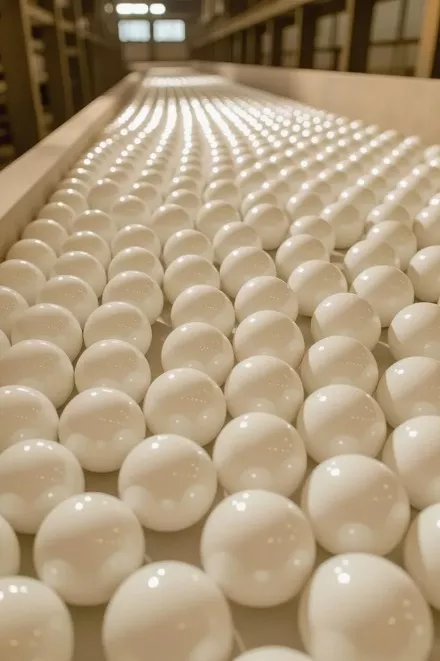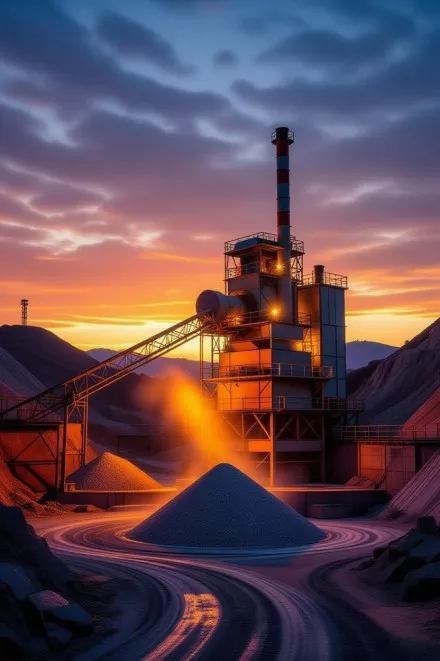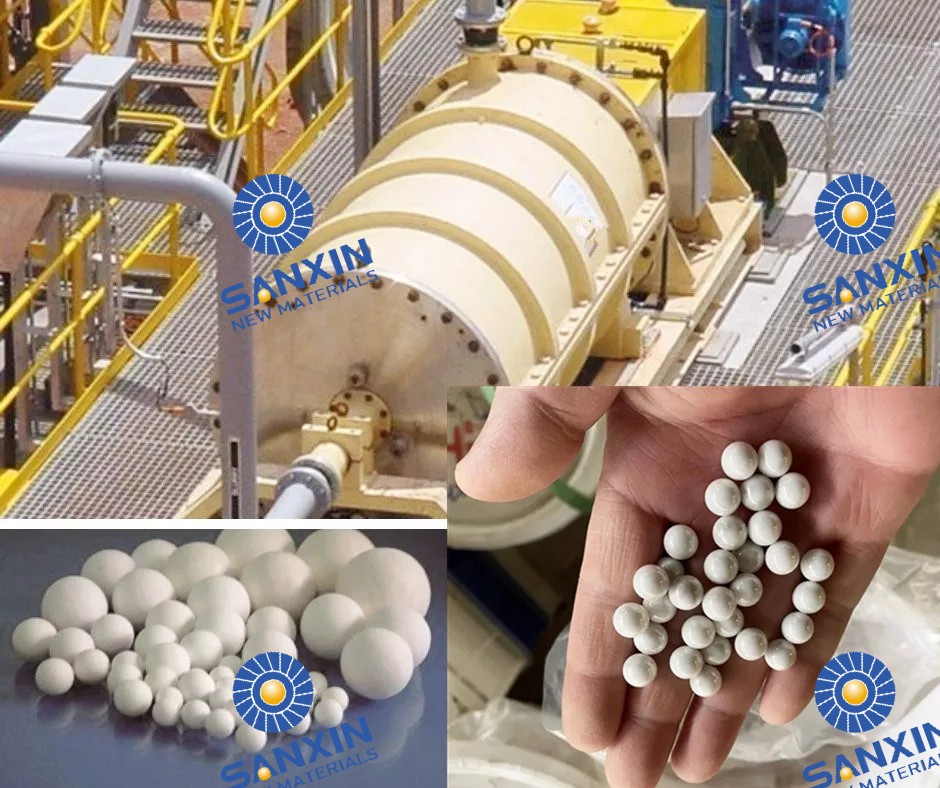The cement industry stands as a cornerstone of global infrastructure, producing the essential binding material that underpins modern construction. In 2024 alone, worldwide cement production exceeded 4.1 billion metric tons, with projections for steady growth driven by urbanization and infrastructure demands in emerging markets. At the heart of this process lies the grinding stage, where raw materials like clinker, gypsum, and additives are pulverized into fine powder in ball mills—a step that consumes up to 40% of the total energy in cement manufacturing. Traditionally, steel balls have dominated as the grinding media of choice due to their durability and cost-effectiveness. However, as environmental regulations tighten and energy costs soar, a paradigm shift is underway toward advanced alternatives like ceramic grinding media.

Ceramic balls, primarily composed of alumina or zirconia composites, offer a compelling upgrade. Their lower density (typically 3.7–4.5 SG compared to steel's 7.8 SG) reduces energy demands, while their inert nature minimizes contamination, leading to higher-quality cement with improved workability and strength. Yet, as highlighted in industry discussions, the transition isn't seamless. When ceramic balls underperform—manifesting as high breakage rates, reduced mill output, or accelerated wear—the culprit is rarely the material itself but rather suboptimal integration into existing systems. Treating ceramics as a direct steel replacement without adjustments can exacerbate issues, turning a potential efficiency booster into a costly headache.
This comprehensive guide expands on the foundational principles of ceramic media optimization, drawing from recent research, case studies, and practical implementations as of October 2025. We'll delve into common pitfalls, key optimization strategies, real-world applications, and forward-looking trends. By the end, cement producers will have a roadmap to unlock 10–20% energy savings, extend media lifespan, and align with sustainability goals like net-zero emissions by 2050. Whether you're retrofitting a legacy mill or designing a greenfield plant, understanding these nuances is key to transforming ceramic balls from a niche option into a system-wide upgrade.
The urgency for such optimizations is palpable. With global energy prices volatile and carbon taxes looming—such as the EU's Carbon Border Adjustment Mechanism—cement plants face pressure to decarbonize without sacrificing profitability. Ceramic media addresses this by slashing power consumption: studies indicate up to 15% reductions in grinding energy without compromising product quality. Moreover, their non-metallic composition eliminates iron contamination, yielding whiter, purer cement ideal for specialty applications like architectural finishes.
But success hinges on holistic adaptation. Mills optimized for heavy steel media often create "dead zones" or excessive impacts that shatter lighter ceramics. Feed inconsistencies, like high moisture or coarse particles, further compound inefficiencies. As we'll explore, addressing these requires a multi-faceted approach: selecting tailored media types, refining feed conditions, reconfiguring hardware, and fine-tuning operational parameters. Backed by data from leading suppliers like SANXIN and Magotteaux, this guide equips operators with actionable insights to achieve not just incremental gains, but transformative performance.
In the sections ahead, we'll dissect each element, supported by empirical evidence and expert recommendations. From the physics of grinding dynamics to economic modeling of ROI, the goal is a 5000-word blueprint for excellence—one that positions your operation at the forefront of sustainable cement production.
When introducing ceramic grinding balls into cement mills, operators often encounter a triad of challenges: elevated breakage rates, diminished output, and heightened wear. These aren't inherent flaws in the technology but symptoms of mismatched configurations. Understanding their root causes is the first step toward resolution, as misdiagnosis can lead to misguided fixes like reverting to steel, forfeiting long-term savings.
Breakage is the most visible red flag, with ceramic balls fracturing under stresses that steel would shrug off. Ceramics' brittleness—despite high hardness (Mohs 8–9)—stems from their crystalline structure, making them vulnerable to point impacts. In a typical ball mill, media tumbles in a cascading or cataracting motion, generating forces up to 100g. For steel balls (density ~7.8 g/cm³), this mass aids absorption; for ceramics (3.7–4.5 g/cm³), the lighter weight amplifies acceleration, concentrating energy on contact points.
Data from a 2024 VDZ research project underscores this: in unoptimized mills, ceramic breakage rates can hit 5–10% monthly, versus <1% for steel. The primary culprit? Inadequate liner profiles. Wave or ladder liners designed for steel promote high lifts (up to 30°), causing ceramics to drop from excessive heights—equivalent to 2–3 times the impact velocity of steel. Add coarse feeds (R0.08 >30%), and the media endures abrasive battering, accelerating micro-cracks.
Case in point: A Southeast Asian plant reported 15% ceramic loss in the first quarter post-installation, traced to unmodified grates that trapped fragments, creating a vicious cycle of uneven loading. Resolution involved profiling liners for gentler cascades, dropping breakage to 2%.
Output dips—often 5–15% initially—arise from altered charge dynamics. Lighter ceramics occupy more volume for equivalent mass, potentially overcrowding the mill and stifling material flow. This "packing effect" reduces the free-fall distance needed for effective fracture, leading to under-grinding and coarser PSD (particle size distribution). Blaine fineness, a key cement quality metric, may fall short of 3500 cm²/g targets, forcing longer retention times and higher energy draws.
A 2023 Powder Technology study compared steel and alumina balls in clinker milling: steel achieved finer particles faster due to superior breakage kinetics, but ceramics excelled in uniformity when fill rates were adjusted downward (from 35% to 28%). Without this tweak, output stalled as media segregated—larger balls migrating to the toe, smaller to the shoulder—disrupting the grinding cascade.
Moisture exacerbates this; feeds >1.5% form sticky beds, cushioning impacts and slashing productivity by 10–20%. In humid regions like India, where monsoon variability is rife, this seasonal slump underscores the need for pre-drying protocols.
Wear manifests subtly but cumulatively, eroding both media and liners. While ceramics boast low abrasion (wear index <0.1 g/hr vs. steel's 0.5), mismatched surfaces accelerate degradation. Smooth steel liners paired with rough-textured ceramics generate slippage, increasing frictional heat (up to 80°C) and thermal fatigue. Over time, this spalls liners, introducing debris that further abrades balls.
Magotteaux's 2023 brochure highlights that unoptimized setups can double liner life for steel but halve it for ceramics due to uneven load distribution. Contamination risks rise too: fractured ceramics release alumina fines, potentially altering cement chemistry and hydration rates.
Economic toll? A mid-sized plant (1 Mtpa) might incur $50,000–100,000 annually in excess wear, per industry benchmarks. Yet, with proper setup, ceramics extend overall media life by 20–30%, flipping the narrative from liability to asset.

These issues interlink—breakage feeds wear, wear hampers output—demanding systemic audits. Tools like DEM (discrete element modeling) simulate media motion, revealing hotspots pre-installation. Vibration sensors and power monitoring flag anomalies early, while PSD lasers quantify grinding efficacy.
In summary, underperformance signals misalignment, not inadequacy. By pinpointing causes—be it liner geometry, feed specs, or charge ratios—operators can reclaim ceramics' promise: 15% energy cuts, purer product, and greener footprints.
Not all ceramic balls are created equal; their efficacy in cement grinding hinges on composition, density, and morphology tailored to dry-milling rigors. Selecting wisely can amplify performance by 25%, per supplier trials.
Alumina (Al2O3) dominates for its balance of hardness (9 Mohs) and affordability, comprising 92–99% purity for high-toughness variants. It's ideal for clinker grinding, resisting abrasion while maintaining sphericity. Zirconia-toughened alumina (ZTA) hybrids enhance fracture resistance by 30–50% via zirconia inclusions, mitigating brittleness in high-impact zones.
SANXIN's lineup exemplifies this: SG3.7 balls suit fine-grinding compartments for energy efficiency, while SG4.5 variants pack punch for coarse stages. Densities correlate inversely with energy use—lower SG reduces lift energy, but higher ensures breakage vigor.
A 2024 Precise Ceramic guide stresses surface finish: rough (Ra 0.8–1.2 μm) grips slurry better, curbing slippage versus polished pharma-grade balls. For cement, avoid high-purity (>99.9%) ceramics; their smoothness suits wet dispersion, not dry cascades.
Size Range: 20–80 mm diameters, with bimodal distributions (e.g., 40% 50mm, 30% 30mm) optimizing void filling. Oversized balls (>60mm) risk breakage; undersized (<20mm) inflate surface area, spiking viscosity.
Toughness Metrics: Impact strength >2 kJ (Charpy test) prevents spalling. Rongsheng's 2024 data shows high-toughness alumina enduring 10^6 cycles versus standard's 5x10^5.
Wear Resistance: Ball mill specific wear <10 g/t cement. Chemshun's alumina media clocks 0.05 g/hr, versus steel's 0.2 g/hr, yielding 4x lifespan.
Thermal Stability: Up to 1200°C tolerance averts degradation in hot mills (60–80°C).
SANXIN's composite balls, tailored for ultrafine cement (Blaine >4500 cm²/g), boast 20–30% lower energy than steel. Their SG4.0 variant, with 95% alumina and zirconia doping, reduced a Chinese plant's kWh/t by 12% in trials. Magotteaux's Keramax MT1, a steatite-based ceramic, saves 20–25% milling time via superior sphericity.
Selection process: Conduct lab-scale tests (Bond work index) on candidate media, scaling to pilot runs. Factor in ROI—initial premiums (2–3x steel) recoup in 6–12 months via savings.
Pro tip: Certify ISO 9001 compliance and request third-party assays for consistency. In nonferrous extensions, like copper regrinding, higher-density options shine.
By prioritizing toughness and texture, ceramic selection becomes a precision tool, not a gamble.
Feed quality is the unsung hero of grinding efficiency; deviations here cascade into media woes. Optimal specs—R0.08 ≤25%, moisture <1.5%—unlock ceramics' potential, boosting throughput by 10–15%.
R0.08, the % residue on 80μm sieve, gauges clinker coarseness post-crushing. Exceeding 25% burdens media with extra breakage work, spiking energy 20% and wear 15%. Finer feeds (<15% residue) promote uniform cascading, as smaller particles fill interstices, enhancing media-material contacts.
A 2023 SAIMM paper on fine grinding notes ceramics excel with pre-fractionated feeds: a -3mm clinker stream yielded 18% finer PSD than coarser inputs. Implement sieving or air classifiers upstream; HPGR (high-pressure grinding rolls) crushes to 90% <2mm, ideal for ceramics.
<1.5% moisture prevents agglomeration, which coats balls and dampens impacts. At 2–3%, "balling" forms, halving efficiency. Hygroscopic gypsum amplifies this; in tropical plants, ambient humidity >70% necessitates dehumidifiers.
Duratec's PDF advises rotary dryers targeting 1% exit moisture, recovering heat from kiln exhaust for 5–10% energy offsets. Sensors (nir or microwave) enable real-time control, averting over-drying costs.
Combine with additives: 0.01–0.05% grinding aids (glycol-based) reduce viscosity, aiding finer feeds. Monitor via online analyzers; aim for d50 ~20μm entry PSD.
Mastering these yields drier, finer feeds—ceramics' sweet spot for peak performance.
Retrofitting mills for ceramics demands targeted mods: feed inlets, partitions, liners, and ventilation. These tweaks accommodate higher fills (+6–10%) and lower densities, lifting output 8–12%.
Narrow inlets (<500mm) choke flow, creating stagnant pockets where media idles. Widen to 600–800mm and add diverters for 10–15% throughput gains. Alpha Grinding Media's 2024 guide recommends CFD modeling to visualize flows, ensuring even distribution.
Worn partitions leak fines prematurely; repair with ceramic liners (alumina tiles) for 2x life. Grates with 8–10mm slots suit ceramics' size range, preventing pegging. A LinkedIn case from 2025 detailed a 7% output boost post-grate upgrade.
Steepen angles 15–20° for ceramics' lighter drop, promoting controlled cataracting. Rubber-composite liners absorb shocks, cutting breakage 40%. Adjust for 35–40% fill, monitoring torque.
Enhanced airflow (via axial fans) drops temps 10–15°C, curbing expansion mismatches. This preserves ball integrity in hot clinkers.
Holistic mods transform mills into ceramic allies, yielding 15% holistic efficiency.
Grading maintains ratios (e.g., 40:30:30 large:med:small) but scales volume up 20% for density drop. Full replacement avoids steel-ceramic mixes, which segregate and double wear.
Charge 30–40% initially, ramping via power draw. Bimodal curves optimize: large for breakage, small for attrition. DEM validates distributions.
Avoid overfill; target 75–85% critical speed. This ensures graded efficacy, minimizing over-grinding.

Empirical evidence abounds, illuminating paths to success.
A 2 Mtpa facility swapped 30% steel with SG4.0 ceramics in a 4.2m x 13m mill. Pre: 35 kWh/t, 3200 Blaine. Post-optimization (liner tweaks, 1% moisture feed): 28 kWh/t, 3600 Blaine, 12% output rise. Breakage fell 70%; ROI in 8 months. Key: 2:1 steel-ceramic ratio prevented overload.
VDZ's project tested Keramax in a lab mill: 15% energy save, no quality dip. Scaled to industrial, a German plant hit 14% savings, crediting feed fineness (<20% R0.08). Challenge: Initial 5% breakage from coarse clinker; fixed via pre-HPGR.
Steel-alumina mix (50:50) in tower mill: Steel faster initial grind but over-fined tails; ceramics uniform PSD, 10% less energy. Full ceramic risked 8% output drop sans grading—lesson: hybrid for transitions.
Ceramics vs. steel in fine grinding: Ceramics 25% less contamination, 18% wear reduction. But steel edged breakage rate; optimization via rough surfaces equalized.
Hybrids bridge gaps; full swaps demand audits. Metrics: Track kWh/t, wear g/t, Blaine. Averages: 12–18% savings, 20% purity gains.
These narratives affirm: Optimization turns potential pitfalls into profits.
Ceramics deliver multifaceted wins. Energy: 15% cuts via lower inertia. Quality: <0.01% iron, boosting aesthetics/strength. Wear: 4x life slashes downtime 30%. Economics: $0.5–1/t savings; payback <1 year.
Sustainability: Reduced CO2 (1 t cement = 0.8 t CO2); aligns with circular economy via recyclable media. Chemshun PDF: 20% less mill wear cuts waste.
In nonferrous, extends to cleaner minerals.
By 2030, AI-optimized charging via ML will predict wear, saving 5% more. Nano-zirconia hybrids promise 50% toughness. Hybrid mills blending VRM/IsaMill with ceramics target 25% efficiency.
Sustainability drivers: Bio-based aids, recycled alumina. xAI integrations for real-time sims.
Ceramic balls, rightly optimized, herald a greener, leaner era. From feed tweaks to grading, each step compounds gains—15% energy, superior quality, robust ROI. Act now: Audit, trial, scale. Contact SANXIN for starters. The future of cement is ceramic-powered—seize it.

Submit your demand,
we will contact you ASAP.

Sanxin New Materials Co., Ltd. focus on producing and selling ceramic beads and parts such as grinding media, blasting beads, bearing ball, structure part, ceramic wear-resistant liners, Nanoparticles Nano Powder

